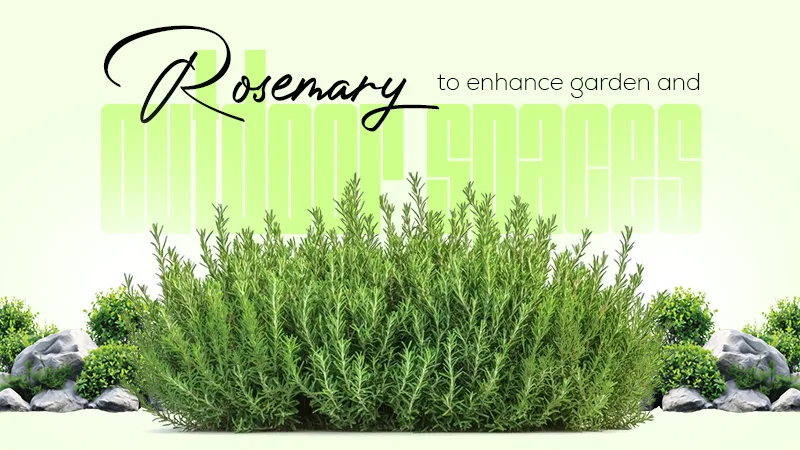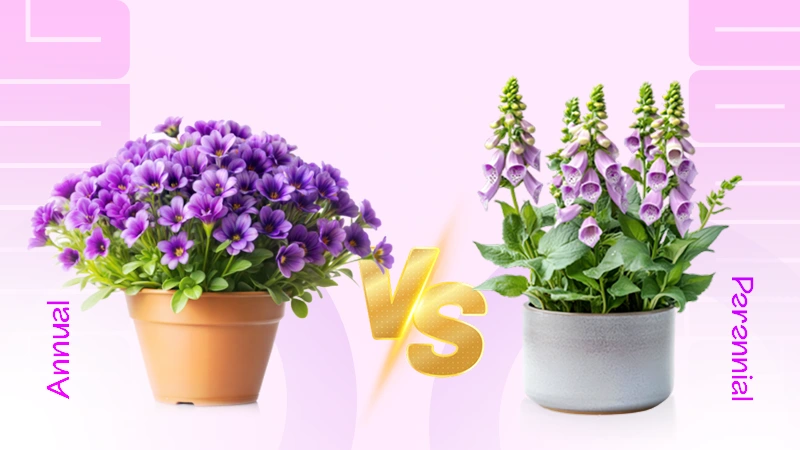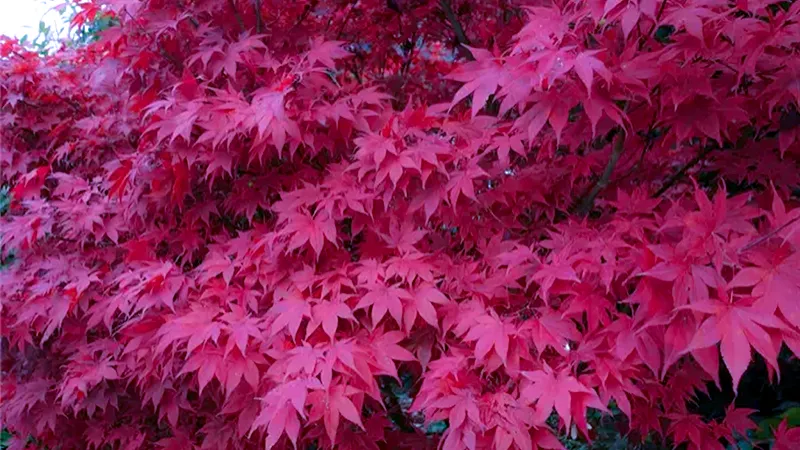
Acer palmatum, famously known as Japanese Maple trees, originally belonged to Japan, Korea, Russia, and Mongolia. These trees are elegant and easy to grow, making them a good choice for gardens and indoor spaces. They come in a variety of species, like upright, weeping, or lace leaf, green and red maple, etc.
Japanese Maples are popular for their vibrant-colored leaves, which depend on the species and season. With their red, purple, yellow, and bright green shades, they instantly add beauty to any place.
Dive further into this article for more in-depth information on Japanese Maple Trees, their variations, cultivation methods, and care tips.
Japanese Maple Tree Overview
Japanese maple trees are renowned for their diverse characteristics. Originally, they were typically collected and named by Japanese natives. However, a few of them got their English names from European countries where they were later transported and cultivated.
These trees also exhibit unique growth habits, with some varieties growing upright while others have drooping branches and weeping leaves. Additionally, they showcase a range of colors throughout the year, which makes them highly attractive.
The seasonal transformation further adds to their distinctiveness, with a variety of leaf shapes, sizes, and colors complementing their overall beauty. In the next section, we’ll learn how to grow Japanese maple trees.
How to Grow a Japanese Maple Tree?
By providing the right conditions and care, Japanese maples can thrive and offer years of beauty to your garden. This section will provide instructions on how to grow them from seeds and cuttings.
Seed
Here’s how you can grow these vibrant Japanese species using the seeds!
- Collect the seeds in the fall when they are dry and brown, falling from the tree.
- For outdoor planting, put the seeds in a paper bag and store them in a cold place. You can skip this step if you plan on planting them indoors.
- Place the seeds in a warm water container for 24 hours.
- Put the seeds in well-draining soil and seal it in a plastic bag.
- Create some holes in the plastic bag for air to pass by and keep it in the refrigerator for 90 days.
- After 90 days, plant your seeds, normally in a pot or the ground; you can skip the refrigerator step if you live in a cold place.
Cutting
Planting the cutting of these trees might be tricky; therefore, use the following steps as guidance:
- Take the cutting in late spring or early summer, when the plant is actively growing.
- Cut at least a 4-6 inch long healthy branch from just below the leaf nod, leaving a couple of leaves on it.
- Dip the end of the branch in rooting hormone to develop root growth.
- Insert the cutting in the pot at least 2 inches (5.08 centimeters) deep with well-draining soil.
- Water the cutting and cover it with a plastic bag or humidity dome to keep the moisture locked in.
- After a month, gently tug on the cutting to check the development of roots. After root development, you are ready to transplant the cutting outdoors or in a larger pot.
You can see your Japanese Maple flourish from a seed or a cutting to a magnificent tree as you apply these techniques.
Japanese Maple Planting Spot
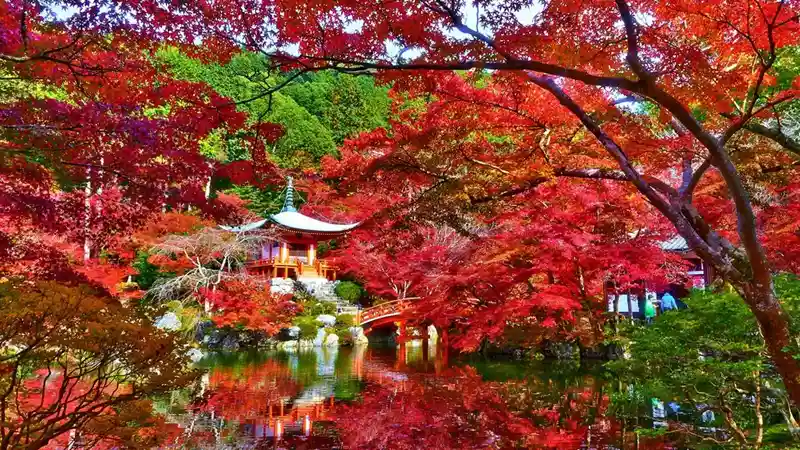
The successful planting of Japanese maple trees depends on factors like tree size and location. They prosper in well-drained, slightly acidic soil and prefer partial shade over harsh direct sunlight. It’s essential to consider sunlight exposure, soil quality, and protection from strong wind and intense sun to ensure their health.
Avoid exposing these Japanese beauties to direct sunlight and strong winds, as these events can lead to dry leaves and can make them more susceptible to decay and damage. With a spread of 15–20 feet, these trees can be pruned to maintain the shape according to the area of growth. They can also be grown as bonsai or in pots; try planting them in large pots so it’s easier for you to move them when required.
Additionally, they should be watered frequently at an early age, so invest in a drainage hole pot. As your Japanese maple grows and matures, it can become valuable. Old trees have high selling value and can turn out to be an asset for you.
How to Care for Japanese Maple Tree?
Sustaining the optimum health of Japanese maple trees can be a bit challenging, especially if you are a novice with zero knowledge and experience about tree planting. So, let’s explore necessary care tips for these colorful trees. From soil requirements to watering and pruning techniques, we’ve covered it all for you!
Location
Finding the correct planting location is the key when it comes to maintaining the health of Japanese Maple trees. Select a site with well-draining soil and appropriate sunlight. For many varieties, morning sun and afternoon shade are ideal. But protection from harsh sunlight and wind is also important for their health. Consider planting on a slope or against a wall for better visual appeal.
Soil
Use draining soil for your tree’s growth; the soil should not remain clogged or flooded, or it will damage the roots of the tree. Enhance the soil with organic materials like compost peat moss, animal manure, garden compost, dry leaves, bone meal, rock phosphate, and super phosphate to give your plant’s roots good and healthy growth. This will also boost the nutritional value of your tree’s soil.
Water
Water regularly to establish roots, especially during dry periods. Apply a layer of mulch around the base to aid in moisture retention. Monitor for pests or diseases and modify care based on seasonal changes and the tree’s health. Water your tree frequently in the initial years, once a week in spring or fall and twice a week in summer. Ensure to water it thoroughly until the water flows down the draining hole.
Fertilizer
In spring, apply fertilizer to your Japanese Maple tree to support its root system. Young trees can also benefit from liquid fertilizer during their premature years. The trees in the pots or containers should be fertilized once every month.
Pruning
Begin shaping the tree as it grows. Remove dead or diseased branches and any crossing branches to maintain the tree’s natural form and health. However, avoid too much pruning, as it can destroy the tree’s natural growth pattern. If cultivating it as a bonsai, trimming can be minimized. You can trim small branches from the end and the ones rubbing against each other.
Method to Grow Japanese Maple Trees as Bonsai
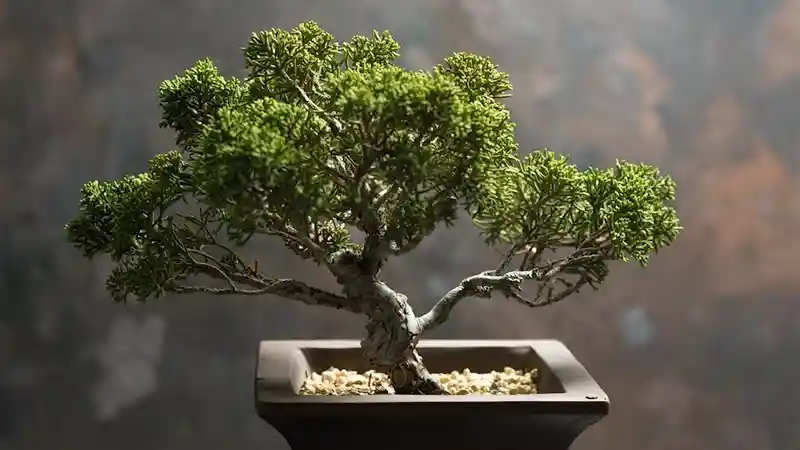
Due to the small leaves of Maple trees’ branching patterns and forms, they can be turned into beautiful bonsai. Japanese and Chinese people utilize the planting art ‘Bonsai’ to transform plants into stunning and valuable art objects.
A special technique is used to turn any maple tree into bonsai, which involves shaping tree branches and developing a compact root system within a bonsai pot. The indoor bonsai should be placed frequently out in nature, so it can grow happily and healthily.
Different Types of Japanese Maple Trees
There is a large variety of Japanese maple, with different characteristics that make them unique and demanding in their own way. Let’s find out a little more about these enchanting species.
1. Crimson Queen
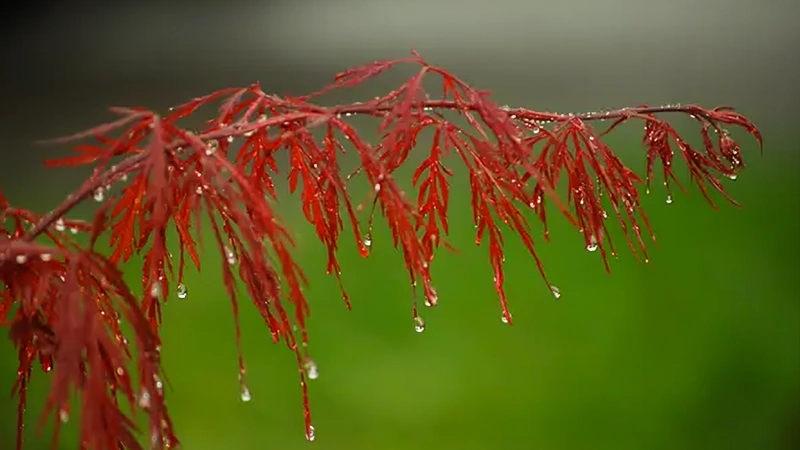
The crimson queen is a very sun-tolerant tree and can be treated like a bush. Its leaves stay crimson red for 3 seasons, which makes it a great option for adding some beautiful red color to your outdoor or indoor garden. The tree is not that long; therefore, the branches of the tree weep down the floor. It requires filtered sunlight and regular watering for healthy growth.
| Scientific Name | Acer palmatum var. dissectum |
| Native Area | Japan, Korea, China |
| Growth Rate | Moderate |
| Size and Spread | 6-8 feet tall, 8-10 feet wide |
| Zone | 5-8 (USDA) |
| Growing Conditions | Partial shade Draining soil Regular watering |
2. Red Dragon
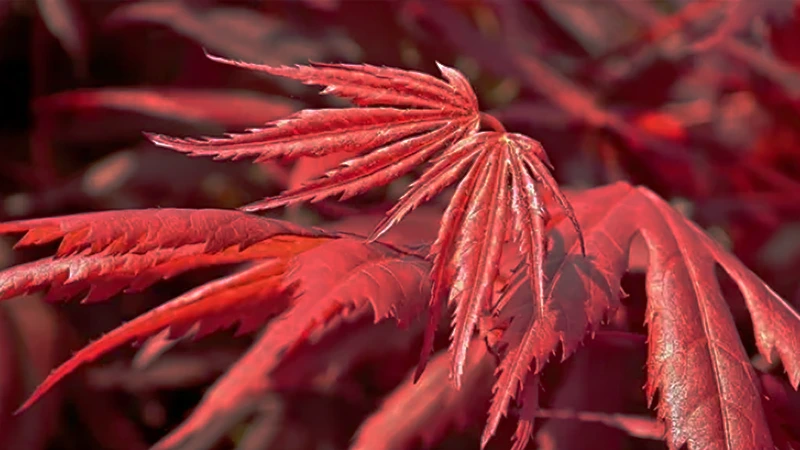
Unlike other Maple trees, the tree is very sun-tolerant and small. The pretty red and purple leaves are almost fringe-like, finely dissected, and pleasing to the eyes. It holds its color well throughout the growing season. The spread and height of the tree is quite small and can be grown in small spaces.
| Scientific Name | Acer palmatum var. dissectum |
| Native Area | Japan, Korea, China |
| Growth Rate | Slow to Moderate |
| Size and Spread | 6-8 feet tall and wide |
| Zone | 5-8 (USDA) |
| Growing Conditions | Partial shade Draining soil Regular watering |
3. Tamukeyama
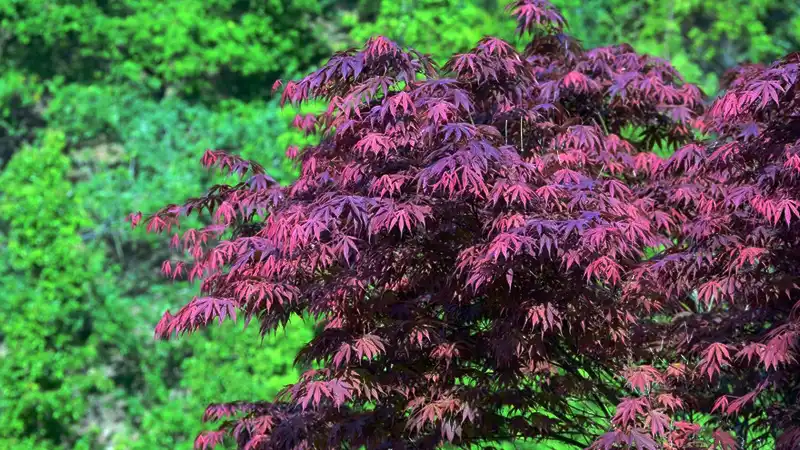
Tamukeyama is one of the favorite dwarfs. Their purple-red leaves that turn bright red in fall and pretty weeping branches make it a popular choice for adding beauty to any basic landscapes and gardens. This species can turn into the most beautiful bonsai due to their height and appearance.
| Scientific Name | Acer palmatum var. dissectum |
| Native Area | China, Japan, Korea |
| Growth Rate | Slow to Moderate |
| Size and Spread | 6-8 feet tall, 8-10 feet wide |
| Zone | 5-8 (USDA) |
| Growing Conditions | Partial Shade Draining soil Regular watering |
4. Coral Bark
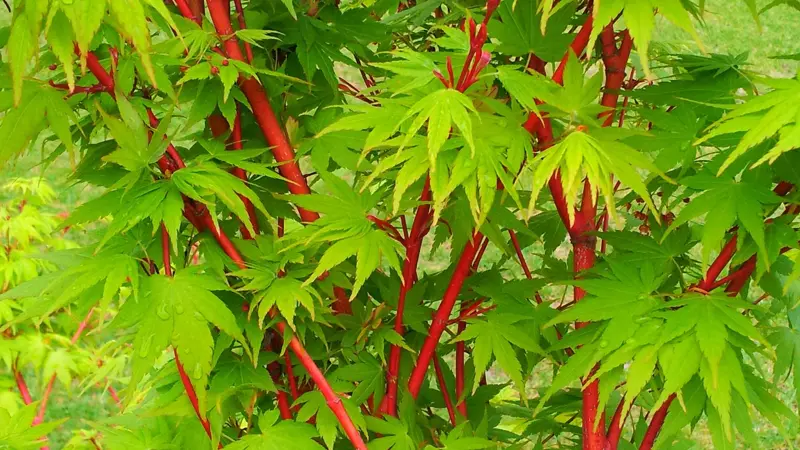
Coral bark is a green Japanese maple tree with a vibrant shade of green leaves on it. Famously known as Sango-kaku, it has red coral bark, which looks pretty striking in the winter. The leaves turn a lovely buttery yellow in the fall and in the winter. In winter, when everything is gray, the tree thrives with its coral bark.
| Scientific Name | Acer palmatum ‘Sango-kaku’ |
| Native Area | Japan, China, Korea |
| Growth Rate | Slow to Moderate |
| Size and Spread | 20-25 feet and 10-15 feet wide |
| Zone | 5-8 (USDA) |
| Growing Conditions | Partial shade Draining soil Regular Watering |
5. Weeping Viridis
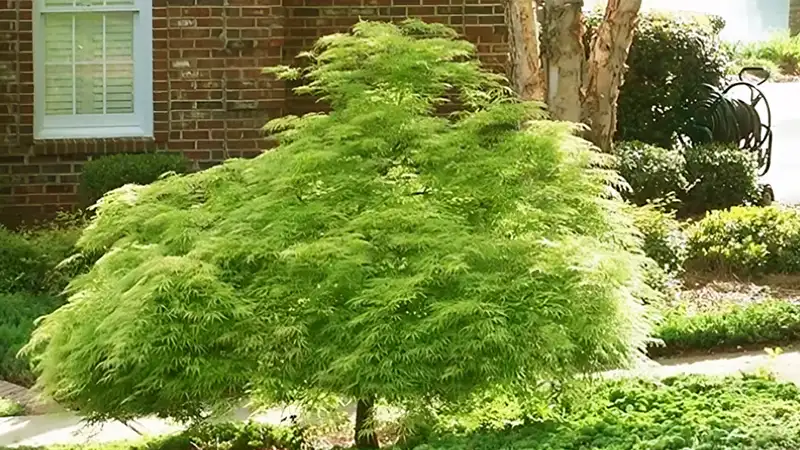
The vivid green, Weeping Viridis, has beautiful leaves that turn golden and crimson in falls. Its finely cut lacy leaves droop down closer to the ground as they mature. Furthermore, the narrow leaves add to its attractiveness, creating a beautiful display throughout the season. The biggest advantage of adding this beautiful tree is that this species can thrive both in warm and cold conditions, so you need not worry about the climatic change.
| Scientific Name | Acer palmatum dissectum ‘Viridis’ |
| Native Area | Japan, Korea, China |
| Growth Rate | Slow to Moderate |
| Size and Spread | 6-10 feet tall, 8-10 feet wide |
| Zone | 5-8 (USDA) |
| Growing Conditions | Partial shade Draining soil Regular Watering |
6. Bloodgood
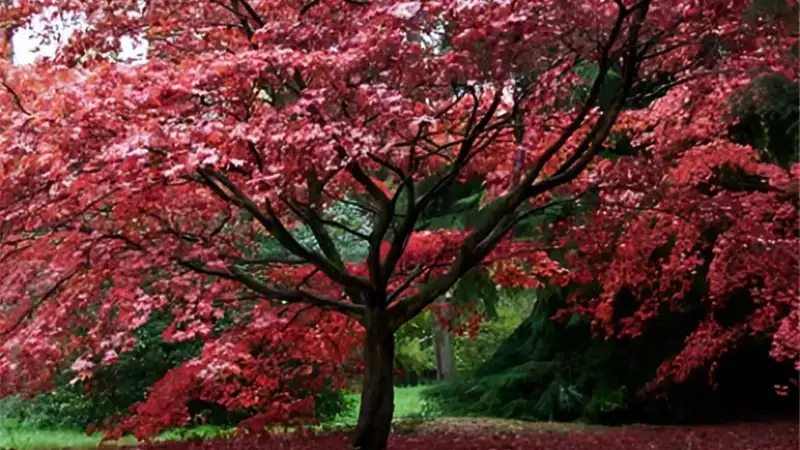
It is one of the most popular Japanese Maples that beautifully thrives both in winter and summer. The color of the leaves changes every season, with a new shade of red. Its leaves are reddish purple in summer, deep pink in spring, crimson in fall, and green in winter.
| Scientific Name | Acer palmatum ‘Bloodgood’ |
| Native Area | Japan, Korea, China |
| Growth Rate | Moderate |
| Size and Spread | 15-20 feet tall and wide |
| Zone | 5-8 (USDA) |
| Growing Conditions | Full Sun to Partial Shade Draining soil Regular Watering |
7. Emperor
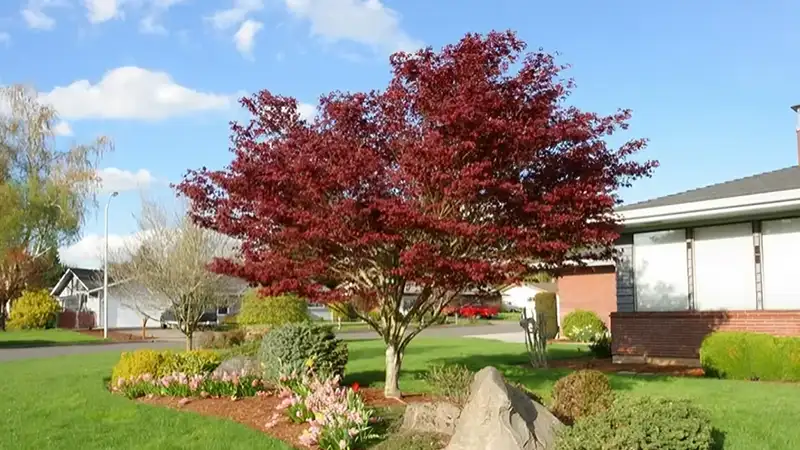
It is a lookalike to Bloodgood, but it grows upright and shorter and has purple-red leaves with black-red bark. The best part about this tree is that its leaves do not fall off easily in winters. Though this tree can survive in full daylight, for better growth, partial shade and well-drained soil are necessary.
| Scientific Name | Acer palmatum ‘Emperor I’ |
| Native Area | Japan, Korea, China |
| Growth Rate | Moderate to Fast |
| Size and Spread | 10-15 feet tall and wide |
| Zone | 5-9 (USDA) |
| Growing Conditions | Full sun to partial shade Draining soil Regular Watering |
8. Purple Ghost
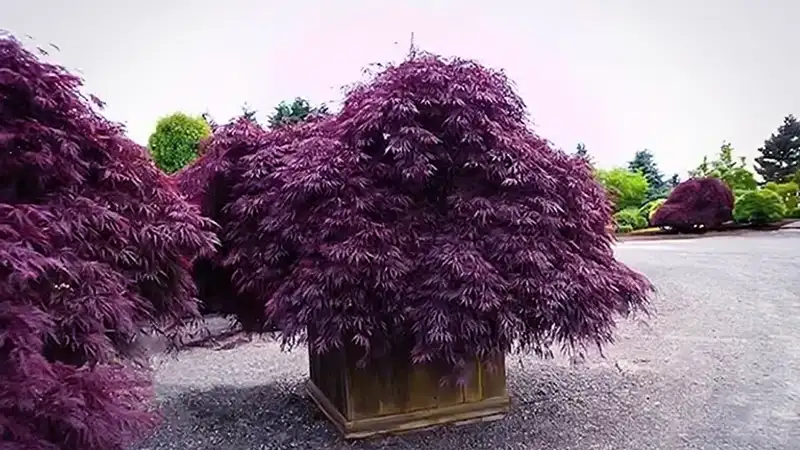
Purple Ghost is a very petite tree and can be grown in a small garden space or in a large pot. Its leaves turn crimson in winter after being bright red in summer. The beauty of this tree can make any space lively. It requires well-draining soil and regular watering for optimal growth.
| Scientific Name | Acer palmatum ‘Purple Ghost’ |
| Native Area | Japan, Korea, China |
| Growth Rate | Slow to Moderate |
| Size and Spread | 10-12 feet tall, 4-7 feet wide |
| Zone | 5-8 (USDA) |
| Growing Conditions | Full sun to partial shade Draining soil Regular Watering |
9. Seiryu
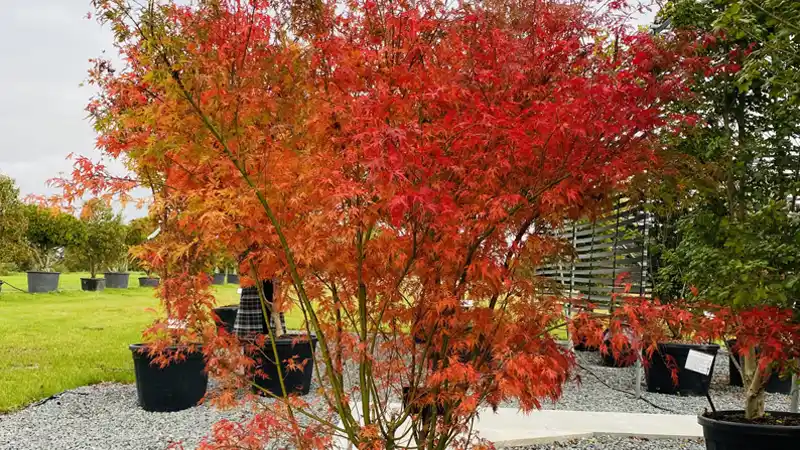
Seiryu is an upright Japanese maple tree with moderate growth habits and lacy foliage. The leaves of Seiryu change from various shades of green to shades of orange and red in fall. Its compact size makes it an excellent choice for smaller gardens, planting containers, and patios.
| Scientific Name | Acer palmatum ‘Seiryu’ |
| Native Area | Japan, Korea, China |
| Growth Rate | Moderate |
| Size and Spread | 15-20 feet tall and wide |
| Zone | 5-8 (USDA) |
| Growing Conditions | Full sun to partial shade Draining soil Regular Watering Slightly acidic soil |
10. Shishigashira
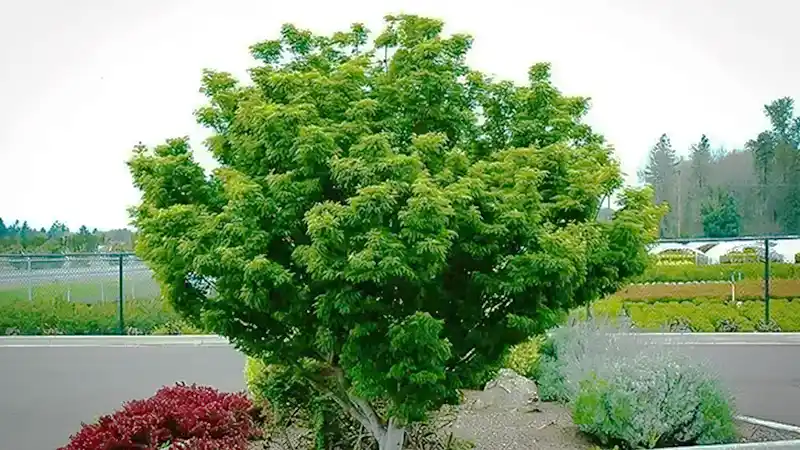
Shishigashira is a dense tree with compact growth and unique leaves that resemble a lion’s mane. The leaves emerge as deep green in spring and transform into vibrant shades of orange and red in fall. Its tolerance to heat and sunlight makes it suitable for warm areas. The unique appearance and design of this tree set it apart from other Japanese maples.
| Scientific Name | Acer palmatum ‘Shishigashira’ |
| Native Area | Japan, Korea, China |
| Growth Rate | Slow to Moderate |
| Size and Spread | 6-10 feet tall and wide |
| Zone | 5-8 (USDA) |
| Growing Conditions | Full sun to partial shade Draining soil Regular Watering |
11. Coonara Pygmy
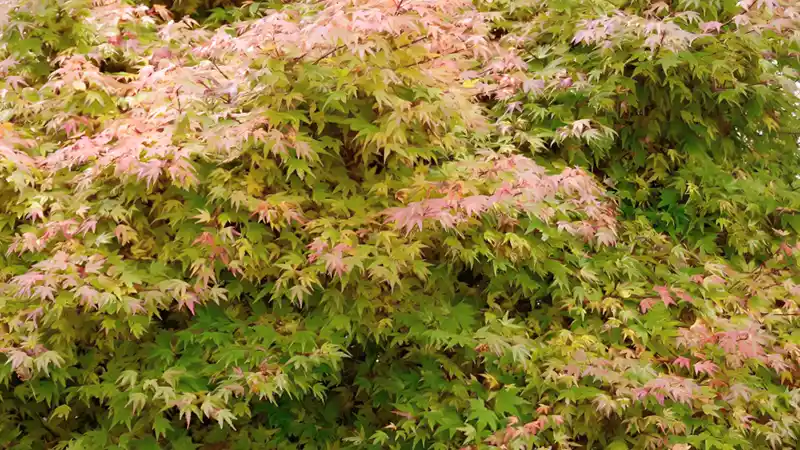
Coonara Pygmy is a dwarf Japanese Maple tree. Due to its compact size and bushy growth habit, it makes a good choice for a small garden. The leaves of Coonara Pygmy are vibrant green in spring and transition to shades of orange, red, and purple in fall. It’s a beautiful and versatile species that can add vibrancy to outdoor spaces.
| Scientific Name | Acer palmatum, ‘Coonara Pygmy’ |
| Native Area | Japan, Korea, China |
| Growth Rate | Slow |
| Size and Spread | 3-6 feet tall and wide |
| Zone | 5-8 (USDA) |
| Growing Conditions | Full Sun Draining soil Regular Watering |
12. Garnet
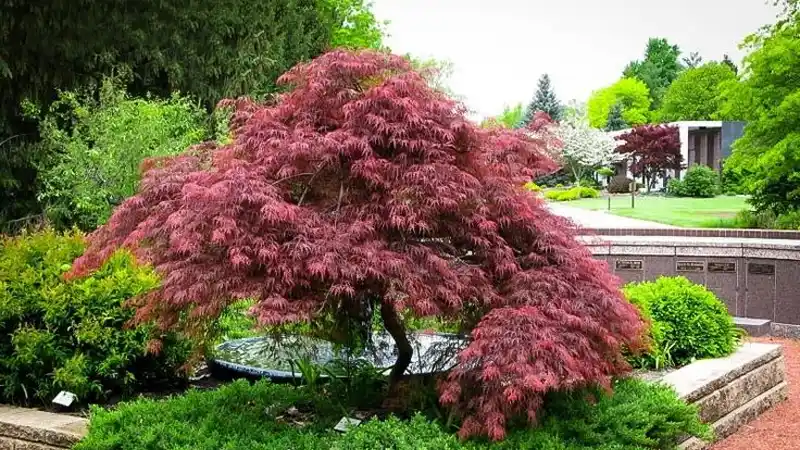
Garnet is a captivating red foliage tree that resembles the color of garnet gemstones. The tree has an upright growth habit, and the leaves transform into vibrant shades of crimson and scarlet in the autumn. It is an effortless and eye-catching species, making it a good pick for an aspiring gardener.
| Scientific Name | Acer palmatum ‘Garnet’ |
| Native Area | Japan, Korea, China |
| Growth Rate | Moderate |
| Size and Spread | 10-15 feet tall and wide |
| Zone | 5-8 (USDA) |
| Growing Conditions | Partial shade Draining soil Regular Watering |
13. Full Moon
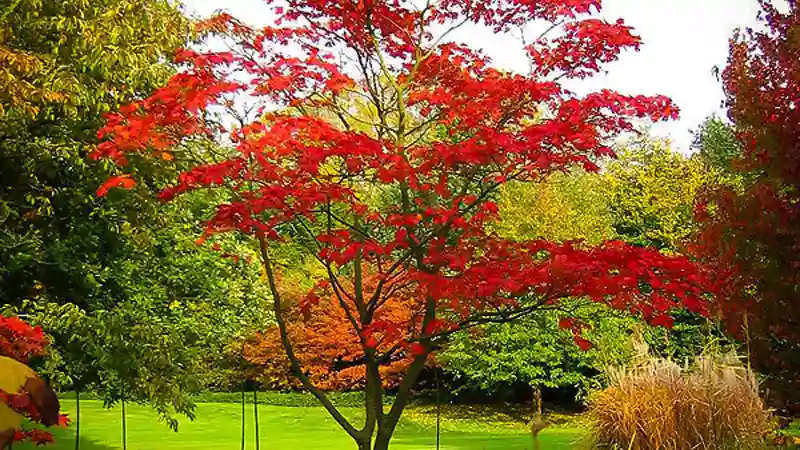
The tree stands out due to its round leaves that emerge in a vibrant golden-yellow in spring. It transitions to hues of green, orange, and red as the year progresses. This species is a popular choice for imparting a touch of brightness and charm to your indoor and outdoor space.
| Scientific Name | Acer shirasawanum ‘Aureum’ |
| Native Area | Japan |
| Growth Rate | Slow |
| Size and Spread | 15-20 feet tall and wide |
| Zone | 5-7 (USDA) |
| Growing Conditions | Partial shade Draining soil Regular Watering |
14. Autumn Moon
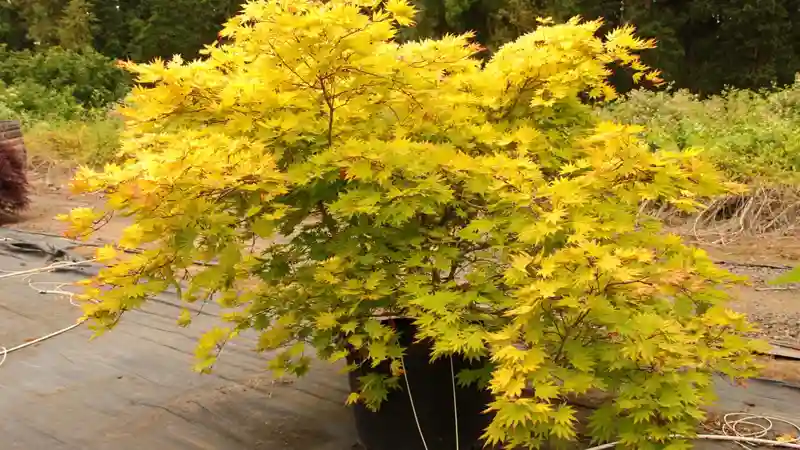
Due to the shades of red and orange, Acer shirasawanum is famously known as Autumn Moon. This tree stands out because of its autumnal beauty all year and is a perfect companion for adding warmth to a garden space. Its unique color palette and minimalist nature make it a good choice for those who want to enhance the beauty of their garden.
| Scientific Name | Acer shirasawanum ‘Autumn Moon’ |
| Native Area | Japan |
| Growth Rate | Slow |
| Size and Spread | 10-15 feet tall and wide |
| Zone | 5-7 (USDA) |
| Growing Conditions | Partial shade Draining soil Regular Watering |
15. Beni Kawa
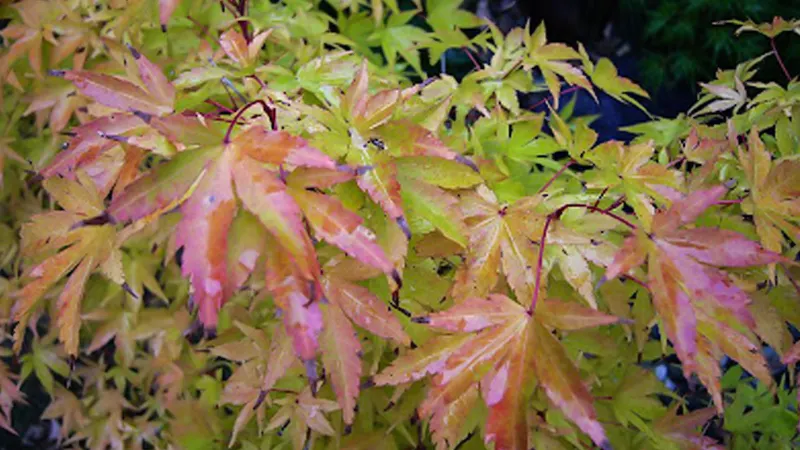
The name Beni Kawa means red river in Japanese, referring to the vibrant red color of the tree bark. Its upright growth habit makes it an elegant choice for adding aesthetic appeal to a garden space. The tree’s unique bark and vibrant leaves give it an aesthetic appeal and make it a great choice for any landscape.
| Scientific Name | Acer palmatum ‘Beni kawa’ |
| Native Area | Japan, Korea, China |
| Growth Rate | Fast |
| Size and Spread | 12-18 feet tall and wide |
| Zone | 5-8 (USDA) |
| Growing Conditions | Partial shade Draining soil Regular Watering |
16. Filigree
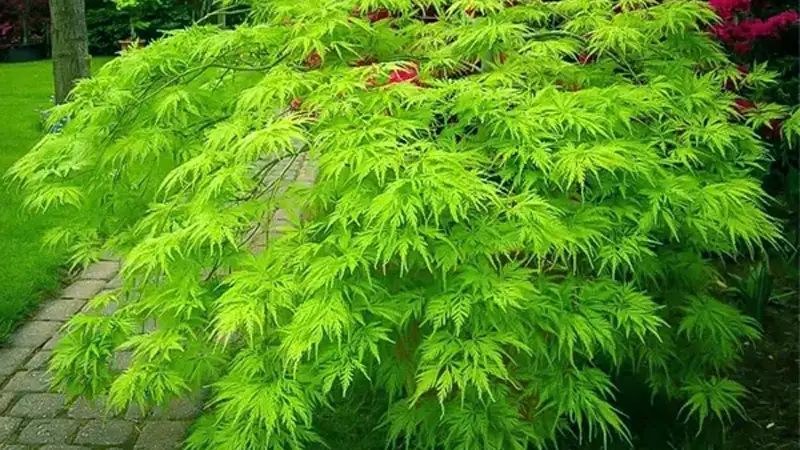
Filigree has a lacy leaf effect with shades of vibrant green in spring and yellow, orange, and red in the falls. It’s cascading and weeping growth habit adds a stunning element to garden landscapes. Furthermore, it’s essential to choose a location with filtered sunlight and well-draining soil to preserve the health of the tree.
| Scientific Name | Acer japoncium ‘Acontifolium’ |
| Native Area | Japan |
| Growth Rate | Slow |
| Size and Spread | 8-10 feet tall and wide |
| Zone | 5-8 (USDA) |
| Growing Conditions | Partial shade Draining soil Regular Watering |
17. Butterfly
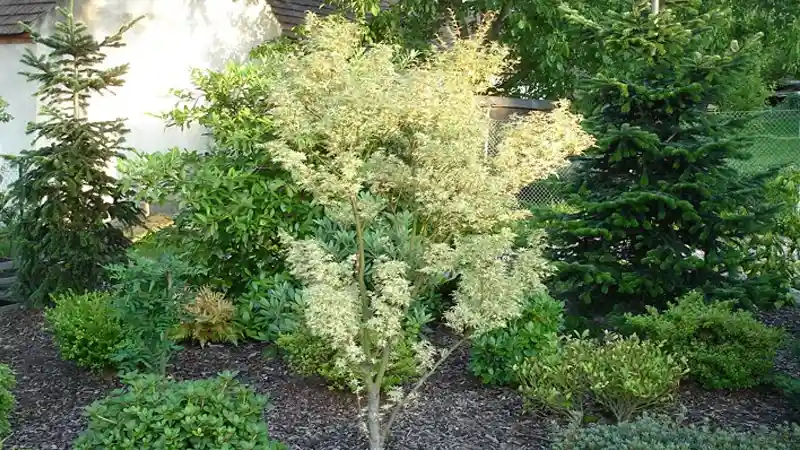
Acer palmatum, also known as a butterfly tree, due to its resemblance to the delicate wings of a butterfly. The leaves produce green, white, and pink tones, creating a captivating display in the garden. It’s a popular choice among gardeners looking to add beauty and a touch of elegance to their landscape.
| Scientific Name | Acer palmatum ‘Butterfly’ |
| Native Area | Japan, Korea, China |
| Growth Rate | Moderate |
| Size and Spread | 6-12 feet tall and wide |
| Zone | 5-8 (USDA) |
| Growing Conditions | Partial shade Draining soil Regular Watering |
18. Peaches and Cream
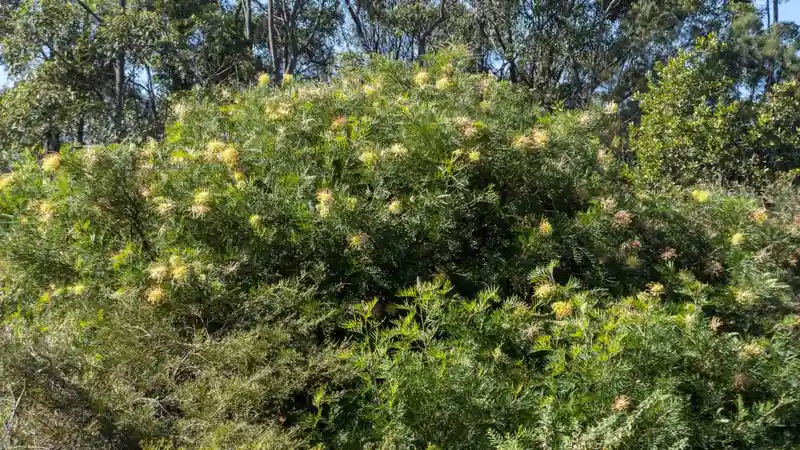
Peaches and cream Japanese Maple trees create a soft and elegant look in the garden by adding a touch of warmth to any space. The leaves transform into shades of orange, red, and golden in autumn. Furthermore, the combination of peach-colored leaves with red highlights makes them eye-catching and visually appealing.
| Scientific Name | Acer japonicum ‘Aureum’ |
| Native Area | Japan |
| Growth Rate | Slow |
| Size and Spread | 8-10 feet tall and wide |
| Zone | 5-8 (USDA) |
| Growing Conditions | Partial shade Draining soil Regular Watering |
19. Higasayama
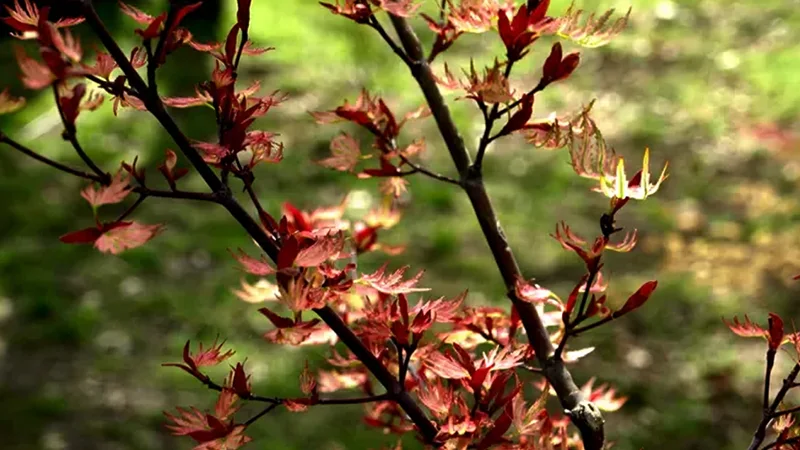
Higasayama is a unique tree with a brilliant crimson color in the fall. It offers a cool and calming presence in the garden. The tree has an upright and compact growth habit that complements a small garden space. Proper care and pruning can help promote and preserve the tree’s foliage and overall health.
| Scientific Name | Acer palmatum ‘Higasayama’ |
| Native Area | Japan |
| Growth Rate | Slow |
| Size and Spread | 10-18 feet tall and wide |
| Zone | 5-8 (USDA) |
| Growing Conditions | Partial shade Draining soil Regular Watering |
20. Hogyoku
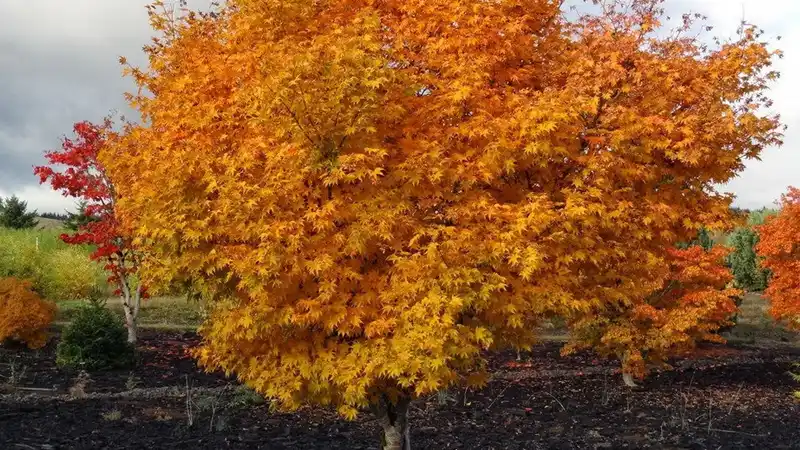
Hogyoku leaves that are unfurled in a soft green hue turn vibrant orange and red in fall. The tree is a combination of elegance, vibrancy, and seasonal interest that enhances the beauty of any place. This tree creates a breathtaking display of autumn colors with its green and golden tones.
| Scientific Name | Acer palmatum ‘Hogyoku’ |
| Native Area | Japan |
| Growth Rate | Moderate |
| Size and Spread | 12-16 feet tall and wide |
| Zone | 5-8 (USDA) |
| Growing Conditions | Partial shade Draining soil Regular Watering |
21. Koto Ito Komachi
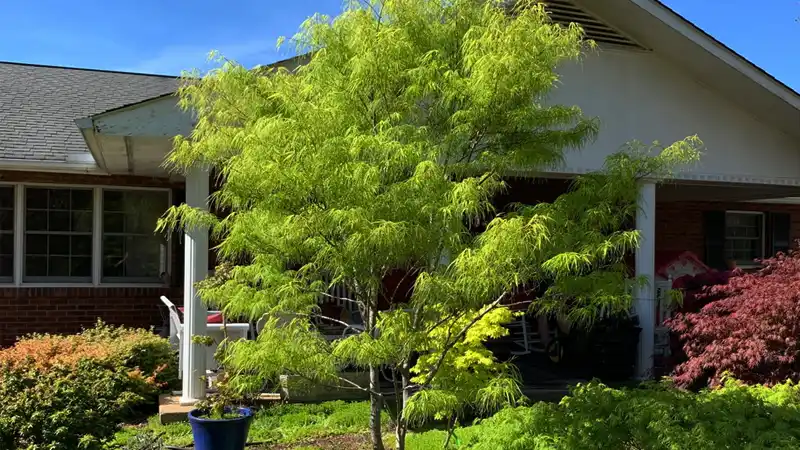
Koto Ito Komachi has delicate and finely dissected leaves that have shades of green with pink edges. As seasons change, the leaves transition to the shades of orange, red, and golden in fall. Its lobed leaves with ridged pinkish-red edges give it a distinct and pleasant appearance, creating an attractive display in the garden.
| Scientific Name | Acer palmatum ‘Koto Ito Komachi’ |
| Native Area | Japan |
| Growth Rate | Slow |
| Size and Spread | 6-8 feet tall and wide |
| Zone | 5-8 (USDA) |
| Growing Conditions | Partial shade Draining soil Regular Watering |
22. Osakazuki
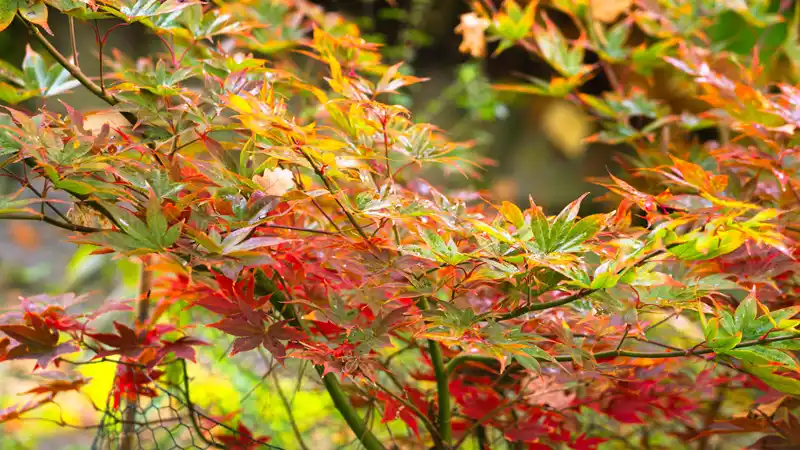
Osakazuki adds a touch of beauty and elegance to any garden space. With its upright spreading growth habit and bold colors, this tree provides a striking look to the landscape. While planting Osakazuki, it’s essential to choose the right location and soil to maintain the optimal growth of the tree. Regular watering and proper care contribute to promoting the tree’s health.
| Scientific Name | Acer palmatum ‘Osakazuki’ |
| Native Area | Japan |
| Growth Rate | Moderate |
| Size and Spread | 15-20 feet tall and wide |
| Zone | 5-8 (USDA) |
| Growing Conditions | Partial shade Draining soil Regular Watering |
23. Usugumo
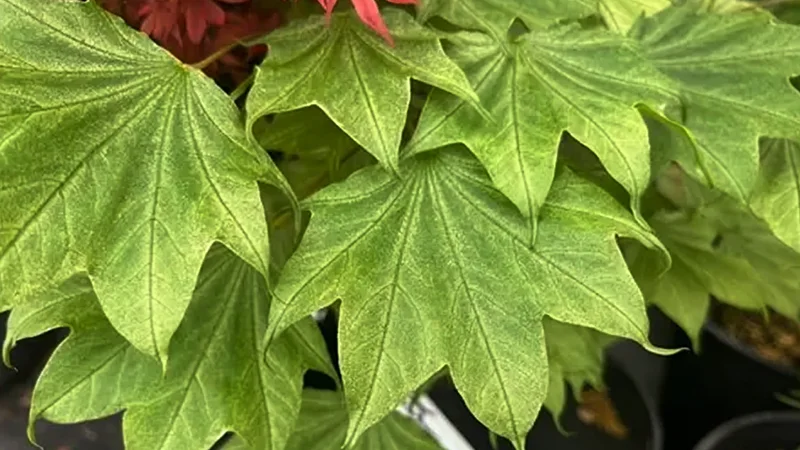
Usugumo adds a touch of beauty to any space with its subtle hues. The leaves transform from soft shades of pink to whites and greens in spring. Its lobed leaves with light and airy texture give it a refined aesthetic, making it an excellent choice for gardeners seeking beautiful outdoor space.
| Scientific Name | Acer palmatum ‘Usugumo’ |
| Native Area | Japan |
| Growth Rate | Moderate |
| Size and Spread | 6-8 feet tall and wide |
| Zone | 5-8 (USDA) |
| Growing Conditions | Partial shade Draining soil Regular Watering |
24. Dissectum Atropureum
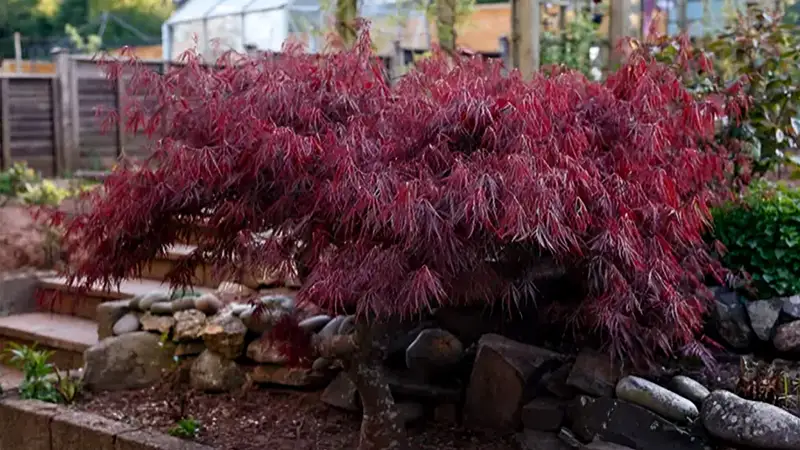
Dissectum atropureum with its lace leaves and rich purple-red hue creates an eye-catching scene. As seasons change, the leaves transition to vibrant crimson red in fall. Its foliage, autumn colors, and display value make it a good pick. The tree thrives in autumn, showcasing its beauty and vibrant color palette.
| Scientific Name | Acer palmatum dissectum atropurpreum |
| Native Area | Japan |
| Growth Rate | Slow |
| Size and Spread | 6-8 feet tall and wide |
| Zone | 5-8 (USDA) |
| Growing Conditions | Partial shade Draining soil Regular Watering |
25. Beni Schichihenge
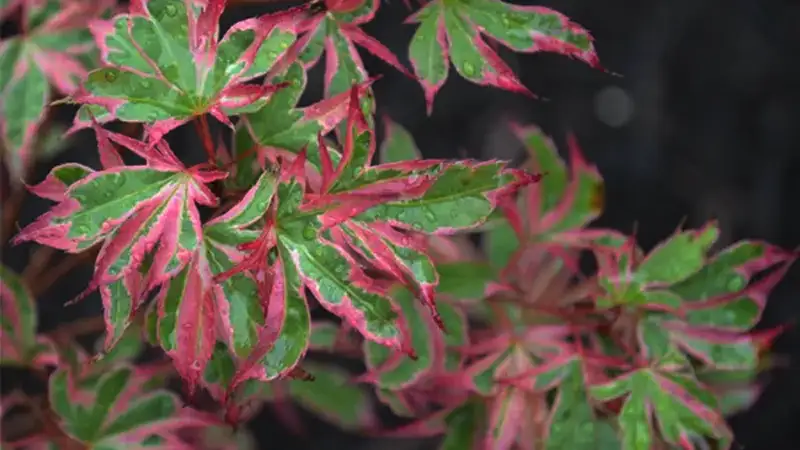
This tree blossoms in spring with a mesmerizing blend of pink, cream, and green hues. Its upright growth habit and color pop make it a good addition to your garden. The vibrant leaves and dynamic colors of the tree can instantly add elegance and charm to any garden space.
| Scientific Name | Acer palmatum ‘Beni Schichihenge’ |
| Native Area | Japan |
| Growth Rate | Moderate |
| Size and Spread | 6-8 feet tall and wide |
| Zone | 5-8 (USDA) |
| Growing Conditions | Partial shade Draining soil Regular Watering |
26. Aconitifolium
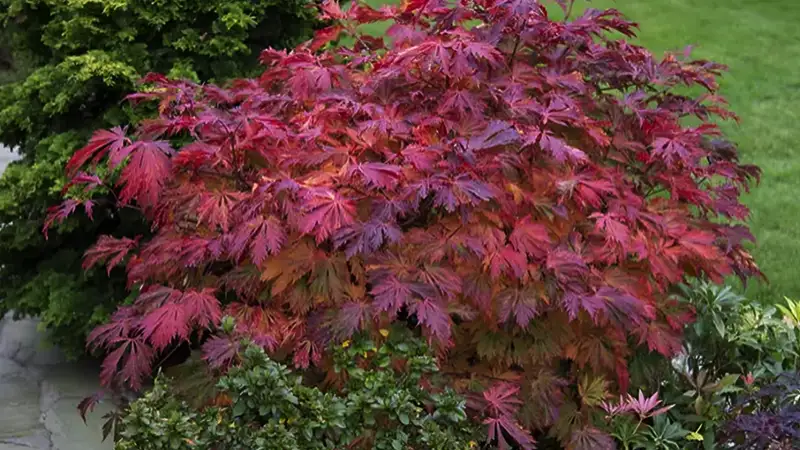
Aconitifolium is popular for its deeply lobed and finely cut leaves. The tree produces vibrant shades of green in spring and transforms to red and orange in spring. It provides a lot of shade in a garden space. Excessive sunlight can damage the tree, so ensure adequate moisture levels during the summer and dry season.
| Scientific Name | Acer japonicum ‘Aconitifolium’ |
| Native Area | Japan |
| Growth Rate | Moderate |
| Size and Spread | 15-20 feet tall and wide |
| Zone | 5-7 (USDA) |
| Growing Conditions | Full sun and partial shade Draining soil Regular Watering |
27. Vitifolium
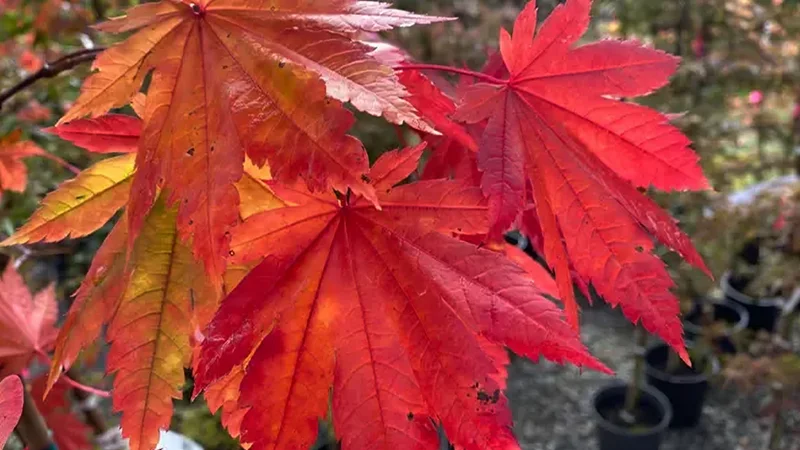
The Vitifolium tree has large, bold, and deeply lobed leaves. It has upright growth and comes in shades of green, red, orange, and yellow. This beautiful tree will add a touch of drama to your garden space in the fall. To maximize the beauty of this tree, you can opt for pruning. It can help shape and remove dead branches from the tree, making it more stunning and elegant for the landscape.
| Scientific Name | Acer circinatum ‘Vitifolium’ |
| Native Area | Japan, Korea, China |
| Growth Rate | Moderate |
| Size and Spread | 15-20 feet tall and wide |
| Zone | 5-9 (USDA) |
| Growing Conditions | Partial shade Draining soil Regular watering |
Pros and Cons of Japanese Maple Trees
Like any other species, Japanese Maple trees also come with their own set of advantages and disadvantages. Let’s take a look at the pros and cons of this species to find out whether they make a perfect plant for your garden.
- Aesthetic Appeal: This species is known for its stunning foliage and vibrant shades of red, greens, and yellows that add beauty to gardens throughout the year.
- Versatility: Diverse landscaping options are possible due to its wide range of sizes, shapes, and leaf colors.
- Size Options: Can be grown in different garden sizes, from small containers to bigger landscapes.
- Low Maintenance: They are relatively low-maintenance and do not require heavy pruning.
- Symbolism: In Japanese culture, the Maple tree symbolizes serenity, peace, and balance.
- Can’t Survive Extreme Climate: Though Japanese Maples need minimal care, they’re still required to be protected from harsh weather.
- Susceptibility to Pests: These trees can be prone to pests like aphids and scale and diseases such as powdery mildew, which can affect their health and appearance.
- Temperature Sensitivity: Japanese maple is not always suitable for very hot or very cold climate temperatures without special care.
- Slow Growth Rate: The slow growth rate can be a problem for those looking for a fast-growing tree.
EndNote
Japanese maple trees can add beauty to any space. Their colors and style of growth can make you fall in love with them. Some may be effortless to grow and some may be hard, but they are worth all the work. If taken care of nicely, they can thrive in any condition and enhance the outdoor beauty of your house.
What is so special about Japanese maple trees?
Japanese maple trees are available in a huge variety with their own uniqueness. They can grow in any region, cold or hot, and have very few pests and diseases.
How big do weeping Japanese maples grow?
They are not too tall trees. Their maximum height is 10 feet, with branches falling down to the ground.
What is the most popular Japanese maple tree?
BloodGood is the most famous Japanese maple tree because it changes its leaf color according to the season. The leaves are reddish-purple in autumn and tend to turn green in summer.

